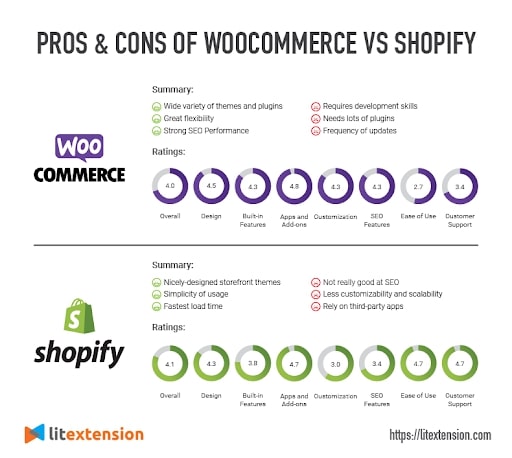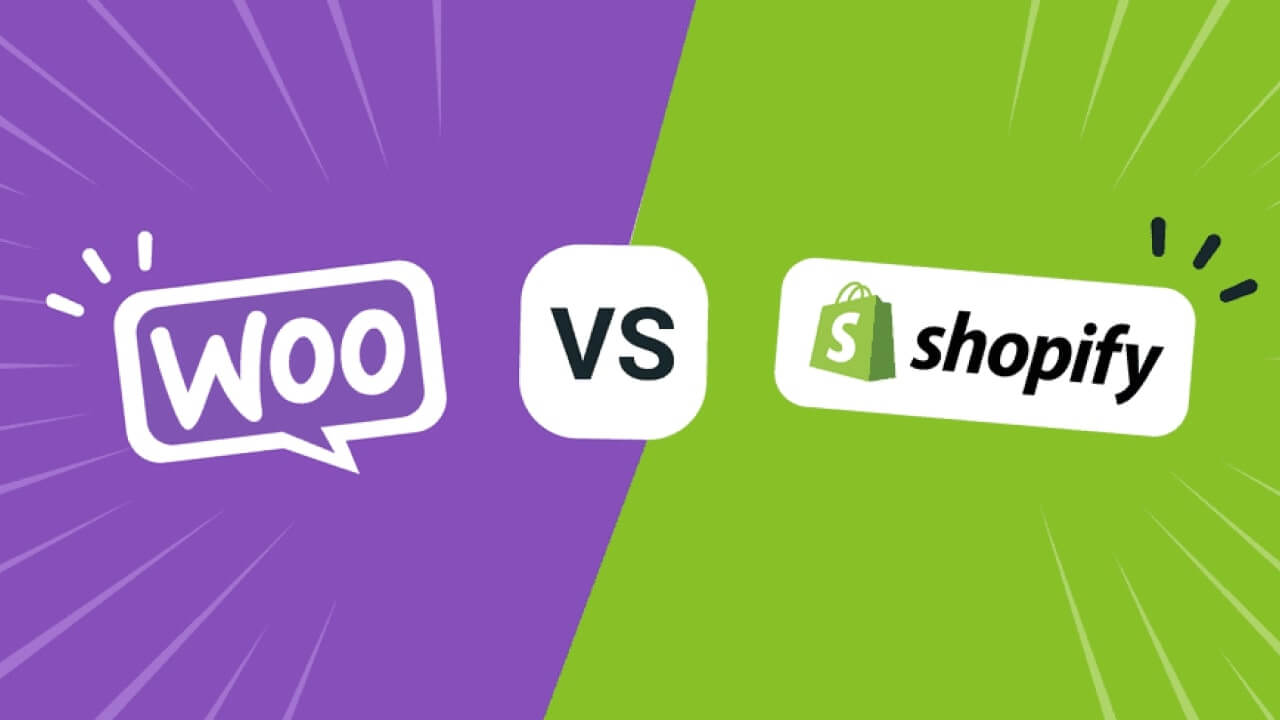Woocommerce and Shopify cater to different needs. Woocommerce offers flexibility, while Shopify provides ease of use.
Woocommerce is a powerful, customizable e-commerce platform built on WordPress. It allows users to tailor their online stores to specific requirements. Shopify, on the other hand, is a user-friendly, all-in-one e-commerce solution. It simplifies the process of setting up and managing an online store.
Both platforms have their strengths and cater to different types of businesses. Woocommerce is ideal for those who need advanced customization and control. Shopify is perfect for those who prefer a straightforward, hassle-free setup. Choosing between the two depends on your business needs and technical skills.

Introduction To E-commerce Platforms
The world of e-commerce is growing fast. Many businesses want to sell online. Choosing the right platform is very important. The right platform can make or break your online store. Let’s explore two popular options: WooCommerce and Shopify.
Importance Of Choosing The Right Platform
Choosing the right e-commerce platform is essential. It impacts your store’s success. A good platform helps with:
- Ease of use
- Customization
- Scalability
- Cost efficiency
Make sure to consider your business needs. Think about your future growth as well. The right choice saves you time and money.
Overview Of Woocommerce And Shopify
WooCommerce and Shopify are popular e-commerce platforms. Each has its own strengths. Let’s break down their key features:
| Feature | WooCommerce | Shopify |
|---|---|---|
| Ease of Use | Requires WordPress knowledge | Very user-friendly |
| Customization | Highly customizable with plugins | Limited but still flexible |
| Scalability | Scales with your website | Scales easily with plans |
| Cost | Free plugin but has costs for hosting | Monthly plans available |
WooCommerce integrates with WordPress. It is open-source and free. You can customize it with many plugins. Shopify is a hosted platform. It offers ease of use and quick setup. Both platforms have their pros and cons. Choose based on your specific needs and goals.
Ease Of Use
Choosing between WooCommerce and Shopify can be difficult. Both platforms offer unique features. Let’s explore their ease of use. We’ll look at their user interface and setup process.
User Interface Comparison
The user interface is the first thing users see. Shopify’s interface is clean and simple. It has a drag-and-drop builder. This makes it easy to design your store. WooCommerce uses WordPress. This offers more customization but can be complex for beginners.
| Feature | Shopify | WooCommerce |
|---|---|---|
| Design | Drag-and-drop | Customizable with WordPress |
| User-Friendly | Very Easy | Moderate |
| Learning Curve | Low | Medium to High |
Setup And Configuration
Setting up your store is crucial. Shopify offers a guided setup. It takes you through each step. This includes choosing a theme and adding products. WooCommerce requires manual setup. You need to install WordPress first. Then, you add the WooCommerce plugin. This can be time-consuming for some users.
- Shopify Setup:
- Create an account
- Choose a theme
- Add products
- WooCommerce Setup:
- Install WordPress
- Install WooCommerce plugin
- Configure settings
Shopify is easier for beginners. WooCommerce offers more flexibility but needs some technical knowledge.
Customization And Flexibility
Customization and flexibility are vital for e-commerce platforms. Both WooCommerce and Shopify offer unique features. Let’s dive into their capabilities to see which one suits your needs.
Theme And Plugin Options
WooCommerce offers a wide range of theme and plugin options. You can find thousands of free and premium themes. These themes cover various business needs.
Shopify also provides many themes. But their choices are more limited. You may find fewer free themes on Shopify. Premium themes are available, but they can be costly.
In terms of plugins, WooCommerce has an edge. It boasts over 50,000 plugins. These plugins offer advanced features and customization. Shopify, on the other hand, has around 6,000 apps. While they are high-quality, the number is less.
Here is a quick comparison:
| Feature | WooCommerce | Shopify |
|---|---|---|
| Themes (Free) | Thousands | Limited |
| Themes (Premium) | Affordable | Costly |
| Plugins | 50,000+ | 6,000+ |
Customization Capabilities
WooCommerce offers more customization capabilities. It is open-source, which means you can modify the code. This flexibility allows for limitless design changes. You can create a unique shopping experience.
Shopify is a closed platform. It offers customization through its theme editor. But you are limited to what Shopify allows. Customizing the checkout process is restricted.
With WooCommerce, you can integrate various payment gateways. The platform supports numerous payment options. Shopify also supports multiple gateways. But some of them come with extra fees.
Here’s a summary of customization capabilities:
- WooCommerce: Open-source, limitless design changes, various payment gateways
- Shopify: Closed platform, limited checkout customization, extra fees for some gateways
Cost Analysis
Choosing the right eCommerce platform involves understanding costs. Let’s analyze the cost differences between WooCommerce and Shopify. This section will help you make an informed decision.
Pricing Structure
Both WooCommerce and Shopify have different pricing structures. WooCommerce is free to use but comes with additional costs. Shopify offers tiered pricing plans. Here’s a breakdown:
| Platform | Initial Cost | Monthly Fees | Additional Costs |
|---|---|---|---|
| WooCommerce | Free | $0 | Hosting, Domain, Extensions |
| Shopify Basic | $29 | $29/month | Apps, Transaction Fees |
| Shopify Advanced | $79 | $79/month | Apps, Transaction Fees |
Hidden Costs And Fees
Both platforms have hidden costs. WooCommerce requires hosting, which can be expensive. Domains and premium themes add to costs. Here’s what to expect:
- WooCommerce:
- Hosting: $5 to $30 per month
- Domain: $10 to $20 per year
- Extensions: $0 to $200 each
- Shopify:
- Transaction Fees: 2.9% + 30¢ per sale
- Apps: $0 to $200 per month
- Premium Themes: $140 to $180 each
WooCommerce gives more control over costs. Shopify offers a simpler setup with predictable monthly fees.
Performance And Scalability
When comparing WooCommerce and Shopify, performance and scalability are crucial factors. Both platforms offer unique advantages. Let’s explore how they fare under different conditions.
Speed And Reliability
Speed is vital for online stores. A slow website can drive customers away. WooCommerce relies on your hosting provider for speed. This can be good or bad, depending on your host.
On the other hand, Shopify is a hosted platform. It handles speed and reliability better due to its optimized servers. Shopify’s infrastructure ensures a fast, smooth experience.
Let’s compare the two:
| Factor | WooCommerce | Shopify |
|---|---|---|
| Hosting | Depends on your provider | Managed by Shopify |
| Page Load Speed | Varies with hosting | Consistently fast |
| Server Downtime | Potentially higher | Minimal |
Handling High Traffic
High traffic can strain any eCommerce platform. WooCommerce depends on your hosting plan’s capacity. You might need to upgrade your hosting during sales or peak times.
Shopify handles high traffic with ease. Its robust servers can manage traffic spikes without issues. This ensures your store remains available and responsive.
Consider these points:
- WooCommerce requires scalable hosting plans.
- Shopify has built-in scalability.
- Shopify offers better performance under high traffic conditions.
Choose WooCommerce if you prefer control over hosting. Opt for Shopify for a worry-free, scalable solution.

Seo And Marketing Tools
Choosing between WooCommerce and Shopify can be tough. Each has unique SEO and marketing tools. These tools help boost your store’s visibility. They also help attract more customers. Let’s dive into the details.
Built-in Seo Features
Both WooCommerce and Shopify have strong built-in SEO features. WooCommerce is a WordPress plugin, so it leverages WordPress’s SEO power. You can easily add meta tags, descriptions, and keywords. This helps improve your site’s ranking on search engines.
Shopify also offers robust SEO features. It has built-in tools for meta tags and titles. It automatically creates a sitemap and generates SEO-friendly URLs. Both platforms allow easy editing of alt text for images.
| Feature | WooCommerce | Shopify |
|---|---|---|
| Meta Tags | Yes | Yes |
| SEO-friendly URLs | Yes | Yes |
| Image Alt Text | Yes | Yes |
Marketing Integrations
WooCommerce excels in marketing integrations. It supports many plugins for email marketing and social media. Popular options include MailChimp, Google Analytics, and Facebook. These tools help track user behavior and optimize campaigns.
Shopify also offers a wide range of marketing integrations. It has built-in tools for email campaigns and social media ads. Shopify supports apps like Klaviyo and Hootsuite. These help you manage your marketing efforts effectively.
- MailChimp: Email marketing integration for WooCommerce.
- Google Analytics: Track user behavior on both platforms.
- Facebook: Social media integration for WooCommerce.
- Klaviyo: Email marketing app for Shopify.
- Hootsuite: Social media management app for Shopify.
Both WooCommerce and Shopify offer powerful SEO and marketing tools. Each platform can help you grow your online store. Choose the one that best fits your needs.
Customer Support
When choosing an eCommerce platform, customer support is vital. Both WooCommerce and Shopify offer various support channels. Understanding these can help you make a better decision.
Support Channels Available
Shopify provides 24/7 customer support. You can contact them through live chat, email, and phone. Their support team is known for quick responses.
WooCommerce, being open-source, relies on community support. Official support is available, but often limited. You can reach out through email or forums.
| Support Type | Shopify | WooCommerce |
|---|---|---|
| Live Chat | Yes | No |
| Yes | Yes | |
| Phone | Yes | No |
| Forums | No | Yes |
Community And Resources
Shopify has a robust knowledge base. It includes articles, tutorials, and guides. Their community forum is active and helpful.
WooCommerce excels in community support. There are many forums, blogs, and video tutorials. The developer community is large and active.
- Shopify offers a structured help center.
- WooCommerce has a vast range of community-created content.
Both platforms have strengths in customer support. Your choice depends on your specific needs.
Final Verdict
Choosing between WooCommerce and Shopify can be challenging. Both platforms offer unique features. Your decision should align with your business needs. Let’s explore the pros and cons of each platform.
Pros And Cons Of Woocommerce
| Pros | Cons |
|---|---|
|
|
Pros And Cons Of Shopify
| Pros | Cons |
|---|---|
|
|
Both WooCommerce and Shopify have strengths and weaknesses. Your choice depends on your specific needs. Evaluate each platform carefully before deciding.

Frequently Asked Questions
What Are The Main Differences Between Woocommerce And Shopify?
WooCommerce is a WordPress plugin, offering flexibility and customization. Shopify is a standalone platform, known for ease of use and support. Both have unique strengths.
Which Is More Beginner-friendly, Woocommerce Or Shopify?
Shopify is more beginner-friendly due to its intuitive interface. WooCommerce requires some technical knowledge but offers greater customization.
Can I Migrate From Woocommerce To Shopify Easily?
Yes, migration tools and services are available. However, it’s best to plan carefully to avoid data loss and downtime.
Which Platform Is More Cost-effective, Woocommerce Or Shopify?
WooCommerce can be more cost-effective due to its open-source nature. Shopify has fixed pricing plans but includes hosting and support.
Conclusion
Choosing between WooCommerce and Shopify depends on your business needs. WooCommerce offers flexibility and customization. Shopify provides ease of use and support. Both platforms have their strengths. Assess your requirements carefully to make the best decision. Remember, the right choice will help your online store thrive.
